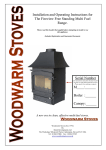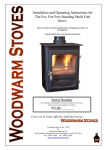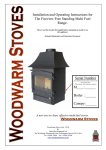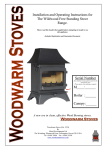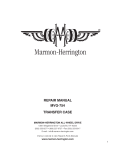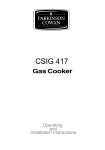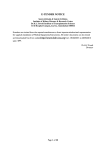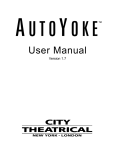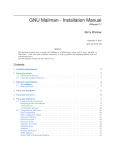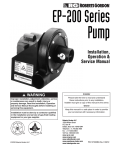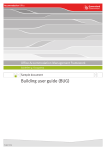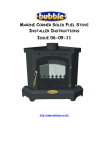Download Woodwarm Stoves Firebright Inset Operating instructions
Transcript
Installation and Operating Instructions for Firebright Inset Smoke Exempt Multifuel Stove. Please read this booklet thoroughly before attempting to install or use this appliance. Includes Registration and Guarantee Document. Serial Number Also detailed on data plate located on the back of the stove door. Please quote when making an enquiry. M______SE:__________ A new era in clean, effective multi-fuel stoves. Woodwarm Stoves Woodwarm Stoves (Est. 1974) By Metal Developments Ltd The Workshop, Wheatcroft Farm, Cullompton, Devon EX15 1RA Tel : 01884 35806 Fax : 01884 35505 www.woodwarmstoves.co.uk 01/06/13 Version INSSE List of Contents General Specifications……………………………………………………. Page 3 Regulations and Installation Instructions……………………………… Hearth……………………………………………………………………….... Stove Site and Minimum Clearances…………………………………… Chimney and Flue………………………………………………………….. Air Ventilation and Free Air………………………………………………. Flue Appliance Outlet Positions………………………………………… Flue Outlet Configuration………………………………………………… Installing the Stove………………………………………………………... Fireboards…………………………………………………………………... Baffle…………………………………………………………………………. Logguard…………………………………………………………………….. Fire Door and Door Catch………………………………………………... Commissioning…………………………………………………………….. Glass Panels — Cleaning and replacement………………………….. Page 4 Page 4 Page 5 Page 5 Page 5 Page 6 Page 7 Page 8 Page 10/11 Page 11 Page 12 Page 12/13 Page 13 Page 14 The Clean Air Act 1993 and Smoke control areas……………………. Page 15 Recommended Fuels………………………………………………………. Page 15 Operating Instructions for the Woodwarm Fireview Stoves How Clean Burn Works………………………………………………….. Lighting…………………………………………………………………….. Initial Lighting (curing paint)……………………………………………... Stove Air Controls………………………………………………………… Running The Stove……………………………………………………….. Extended Burning………………………………………………………… Things To Avoid…………………………………………………………... Operation of the grate……………………………………………………. Daily Routine, Maintenance and Servicing…………………………….. Page 16 Page 16 Page 16 Page 16 Page 17 Page 17 Page 17 Page 18 Page 19 Chimney Fires……………………………………………………………….. Page 20 Fault Finding…………………………………………………………………. Page 20 Fume Emission……………………………………………………………… Page 20 Maximum Operating Temperature……………………………………….. Page 21 The Woodwarm Guarantee……………………………………………….. Page 21 Details of Product Registration………………………………………….. Page 22 Spare Parts…………………………………………………………………... Page 22 Useful Contacts……………………………………………………………… Page 23 General Specifications - Inset Stove Class 1: BS EN 13229:2001 + Amd 2:2004. For Intermittent use only. Unsuitable for use in a shared flue system. Use only seasoned wood logs only. Table 1 Air Inlet grills must be so positioned that they are not liable to blockage. Nominal Heat Output Kw 5 Space Heating Kw 5 Efficiency% (wood) 79 Efficiency% (solid fuel) 70.7 Co Emission @13% O2 (wood) 0.31 Co Emission @13% O2 (solid fuel) 0.14 Weight Minimum Clearance From Combustibles Above 350mm Side 100mm Recommended Refuelling Intervals (hours) 1.5 Maximum Log Length 280mm Overall Height (Body in room) 620mm Overall Height (Rear box in wall) 551mm Overall Width (Body in room inc. top) 552mm Overall Width (Rear box in wall) 400mm Overall Depth (Body in room) inc. door) 106mm Overall Depth (Rear box in wall) 310mm Flue Outlet Size 127mm Flue—Centre Line to rear of Convector Box 95mm (vert.) Stove Fire Boards 56 Side Board( mm) (2 Required) 142 320 282 148 280 Rear Board (mm) Metal Developments Ltd reserve the right to change sizes and specifications without notice. 290 x 147mm E&OE Or 45 deg. REGULATIONS AND INSTALLATION INSTRUCTIONS FOR WOODWARM STOVES All local regulations, including those referring to national and European Standards (BS 6461, Installation of chimneys and flues for domestic appliances burning solid fuel (including wood and peat) & BS 8303, Code of practice for installation of domestic heating and cooking appliances burning solid mineral fuel) need to be complied with when installing this appliance. Health and Safety at Work It is the responsibility of the installer to comply with current Health and Safety Regulations, and particular attention should be given to the following:Asbestos This stove contains no asbestos. If there is a possibility of disturbing any asbestos in the course of installation then please seek specialist guidance and use appropriate protective equipment. Handling This stove is heavy and adequate facilities must be available for all handling operations and its final manoeuvre into position. In order to lighten the stove, the main door may be removed. The baffle and grate bars can also be removed. Glass Care should be taken when handling the door that the glass is not knocked. The door is double glazed. Fire Cement Some types of Fire Cement are caustic and should not be allowed to come into contact with the skin. In cases of contact, wash off with plenty of water. Electrical If any electrical components are used in the installation they should be installed in accordance with the manufacturers installation instructions and all wiring must comply with the current I.E.E regulations and the by-laws of the local water authority. Air Supply Building Regulations dictate that an air vent of some type (usually an air brick) must be fitted into an exterior wall to allow sufficient flow of air into the fire. Air Inlet grills must be so positioned that they are not liable to blockage. This stove should not be fitted in a room where an extractor fan is in use, as this could result in flue reversal and the emission of flue gases into the room. A carbon monoxide alarm must be fitted to BS EN 50291:2001 HEARTH The stove must stand on a fireproof hearth which must be at least 127mm thick and constructed of a noncombustible material. The positioning of the stove and the size of the hearth is governed by Building Regulations for Class 1 Appliances. These regulations state that the hearth must extend at least 225mm in front and 152mm to the side of the stove. This can be covered with decorative tiles so long as these are also non-combustible. SUPER IMPOSED HEARTH This Stove is not suitable for a Super imposed hearth as it exceeds the allowable temperature. This type of hearth is usually defined as being: A minimum 12mm non-combustible material e.g. slate, glass, steel. 4 STOVE SITE AND MINIMUM CLEARANCES There must be no combustible material (i.e. plaster board, wooden wall panels, skirting boards, beams etc) within a specified distance to the rear and sides of the stove, these can be found on table 1 page 3. CHIMNEY AND FLUE The chimney should be thoroughly swept and examined for soundness. If the chimney is not lined, then we recommend strongly that before use it is fully lined with a Class 1 Liner and insulated (we recommend no more than 600mm single skin flue from the appliance). It is not advisable to only partially line a chimney as this will only create further problems where the lining finishes. If there are even the smallest air breaks in the mortar, the chimney is not suitable for a wood stove. When hot flue gases rise up the chimney, it will pull cold air through any small break. This cools the flue gases at that level causing wood tar to precipitate at that point on the chimney wall. Soon this will accumulate across the chimney and therefore constrict it and stop the fire burning properly. Eventually this will not only lead to a chimney fire, but will further rot the chimney structure. If the chimney is not lined and was previously used for an open fire then there is a possibility that the higher temperatures produced by this closed appliance will loosen deposits. It will be necessary to have the flue swept and inspected by a registered sweep one month after the initial installation. In the absence of a chimney one of the following must be used either internally or externally:- a prefabricated block chimney, a conventionally constructed chimney with a Class 1 liner, or a twin walled insulated flue to BS 4543. The internal diameter must not be less than that of your particular appliance. Flues must be fitted in accordance with the manufacturers' instructions and according to local Building Regulations. If there is any doubt over the flue connection or the installation, consult your nearest professional installer, or the Building Inspector at your local council. Whichever chimney option you choose to use DO NOT FORGET TO POSITION A CLEANING ACCESS (if applicable) in your flue and chimney that is easily accessible for sweeping. Note: Clay liners can create a cool upper internal temperature which can lead to condensation problems, especially if the liners are not back insulated. If a clay liner is already in place we recommend lining with class 1 liner. For efficient stove working it is important to make sure that there is an adequate draw on the chimney. The chimney height should not be less than 4.5 metres measured vertically from the outlet of the stove to the top of the chimney. With a minimum flue draft reading of 0.05mbar (0.02”wg) when warm, increasing to 0.15mbar (0.06”wg) when hot. These readings should be taken using secondary air and all fire doors closed. The minimum flue size for these stoves varies according to the model, refer to the specification sheet (table 1 page 3) for the minimum flue diameter. If possible line the chimney with a flue liner that is at least 25mm (1") larger than that of your particular stove. At no point in the flue should it be below the minimum flue diameter. This appliance is unsuitable for use in a shared flue system. If elsewhere in the house another fireplace feeds into the same chimney this must be sealed, otherwise flue gases or air may either be drawn into or escape from, the other chimney or fireplace. This would contravene Building Regulations as it is potentially very dangerous. CHIMNEYS, FLUES, COMBUSTION, AIR SUPPLY AND POSITIONING OF THE STOVE In addition to these installation instructions, Building Regulations and Local Authority By-Laws regarding flues and positioning of the appliance. (Building Regulations Document J must be observed). AIR VENTILATION AND FREE AIR: The stove requires 550 mm2 of FREE AIR space per KW input in excess of 5kw. Therefore, a 9kw input appliance requires 2200mm of free air. 9KW - 5KW = 4KW 4KW x 550mm2 = 2200mm2 There must not be a extractor fan fitted in the same room as the stove as this can cause the stove to emit fumes into the room. 5 Flue - Appliance Outlet Positions Fig. 1 Point where flue passes through weather surface (Notes 1,2) A B at or within 600mm of the ridge. elsewhere on a roof (weather pitched or flat) Clearances to flue outlet at least 600mm above the ridge. at least 2300mm horizontally from the nearest point on the weather surface and: a) b) C D below (on a pitched roof) or within 2300mm horizontally to an openable rooflight, dormer window or other opening. (Note 3) Datum for horizontal measurements at least 1000mm above the highest point of intersection of the chimney and the weather surface; or At least as high as the ridge. 150mm max Datum for vertical measurements At least 1000mm above the top of the opening. within 2300mm of an adjoin- at least 600mm above the adjacent ing or adjacent building, building. whether or not beyond the boundary. (Note 3) Notes 1) The weather surface is the building external surface, such as its roof, tiles or external walls. 2) A flat roof has a pitch less than 10o. 3) The clearances given for A and B, as appropriate, will also apply. The datum for vertical measurements is the point of discharge of the flue, or 150mm above the insulation, whichever is the lower With acknowledgement to Building Regulations Document J 6 Flue Outlet Configuration Fig. 2 Fig. 2b Fig. 2a Rain Cap Flue Vent Minimum 4.5mtrs Flexible Liner Solid flue section to prevent Brush damage M.A. Adaptor 45 Degree Outlet position Vertical Outlet position 7 INSTALLING THE STOVE Warning: — Use packing to avoid damage to underside Air Controls when moving on trucks! Ensure that the Air Controls move freely before final positioning and installing Always leave Air Controls open to shake out any loose material when moving stove ( If jammed, spin off the 6no domed nuts and clear obstruction) Remember to leave sufficient clearance in front of the stove for the fire door to open fully when finally positioned. Remove any packaging materials. The shrink polythene can be used as a cover for the stove whilst installation is in progress There is normally a piece of cardboard , for protection, behind the door glass. All other pieces of board in the stove are the fire boards. Turn the handle and open the fire door then carefully remove it by lifting up and off its hinge pins (retaining these) and place it safely out of the way. From the front of the stove you can now remove the operating tool, baffle, fire boards, the grate bars and ashpan if necessary. The ashpan can be used for holding the grate bars if you need to remove them, which can be done easily by rotating them fully open then lifting each one out of the grate link bar, outwards and upwards. SEPARATE THE STOVE AND CASSETTE BOX Separate the stove from the cassette box by removing the 2no M8 screws & Flue Connector ( seen in Fig. 9) as Well as 1no m8 screw in the ashpit (seen in Fig. 8) Fix the Flue Outlet to the liner as per Fig.3, using Stainless Steel Self Tapping screws. Note: When exiting the stove, other than vertically (as Fig. 3), it is advisable to also use a solid section of flue. This will help prevent damage to the liner, as the chimney brush tries to exit the stove during sweeping After checking that the rope seal is in place (visible in Fig. 3), pull the Liner up the Chimney temporarily, whilst the Cassette box is positioned. Fig. 3 There are two accepted methods of fitting: 1. 2. Pre install Rockwool slab insulation to the sides, top and rear of either the prepared opening, or Cassette Box then fix the Cassette, both down and backwards through any of the holes provided, in order to prevent the assembly moving out of it’s opening in the course of time. Fix the Cassette box, both down and backwards as per above, then using a 6 :1 mixture of Vermiculite and Cement, applied through the Flue Hole, fill the cavity around the back and sides of the Cassette box, level with the top. 8 Fig. 4 The prepared opening awaiting installation of Rockwool slab material prior to the Cassette box . In this case the opening was high enough to allow insulation to be fitted around the flue after the Cassette was installed Fig. 5 The Cassette Box will need fixing in to avoid it moving out of position after a period of time Fig. 6 Filling the cavity around the Cassette with a mixture of Cement and Vermiculite 9 With the Cassette Box, the Adaptor and it’s 2no M8 threads should come through their respective holes and the ‘Joining Nuts’ can be screwed on and tightened fully. IMPORTANT Press down the retainers to captivate the ‘Joining Nuts’ (Arrowed Fig. 7) Push the Pre formed circular 8mm Rope Seal , into the groove (visible in Fig. 7). Position the Stove inside the Cassette Box and fit the lower bolt ( Fig.8. M8 x 20) loosely for now . Fig. 7 Fig. 8 Fig. 9 Check that the Flue connector has a flat rope seal on it’s upper face (not visible in Fig.9) and that it inserts up into the seal and groove above. Fix with 2no M8 x 25 Set Screws provided and tighten just enough to accomplish a good flue seal. NOTE: The stove may need to be either pulled out of the box slightly or pushed to obtain alignment of screw holes and threads. IMPORTANT : Adjust level bolts prior to final assembly FIRE BOARDS These stoves are suitable for both wood and solid fuel, The interior of the fire chamber on all of our stoves is lined with 30mm Mica based fire resistant board. There are three pieces, one at the rear under the baffle and flue outlet and one on either side of the stove. Fig3 These fire boards are ready cut to size and shape and may be packed loose to prevent damage. They are very fragile so handle with care, especially when loading with fuel. They have a relatively short life, especially when burning coal, so do inspect them regularly and replace if they begin to deteriorate by showing signs of breaking up or wearing thin. The fire board is important for efficient combustion and is not covered by any warranty as it is considered a consumable product. The replacement sizes are provided under Stove Fire boards on table 1 page 3. 10 Fig. 10 Side Fire Board Rear Fire Board BAFFLE The smoke baffle sits on the Fire boards as shown in Fig.11 and Fig.12. Ensure baffle seats squarely on boards and is pushed fully to the rear. Fig. 11 How to insert Baffle through doorway Baffle in position Fig. 12 11 LOGGUARD Fig. 13a Fig. 13b FIRE DOOR - ALL MODELS Replace the door by aligning it over the hinges and working the door downwards whilst at the same time, gently swinging it. Warning: Use a second person to take the weight, as the door is heavy. Check when refitting the fire door that the rope seal on the inner face of the door is making an even contact with the stove body when the door is closed. Your Woodwarm stove is supplied with a heat resistant glove to operate the door handle e.t.c., when hot. Turn handle to clockwise to open and turn anti-clockwise to lock. The door catches can be adjusted but ensure that the lock nuts are tight and the catches are pulling evenly and positioned pointing straight down( Fig. 15) . This appliance must only be used with the door closed Fig. 14a To Open To Close Fig. 14b 12 DOOR CATCH Fig. 15 COMMISSIONING On completion of the installation and after allowing a suitable period of time for any fire cement or mortar joints to dry out, the stove should be cleaned using a soft dry cloth. Check joints and seals. The stove can then be lit and checked to ensure that smoke is taken from the appliance up the chimney and emitted safely. The customer should be advised on the use of the appliance. On completion of the installation and commissioning please leave these operating instructions with the customer. HETAS LTD APPROVAL These appliances have been approved by HETAS Ltd and Defra as an intermittent operating appliance for burning the fuels listed on page 15 13 GLASS PANELS There are two panels of glass in each door. They are made of a heat resistant ceramic product which will not break with the heat of the fire. However, it is important to maintain the movement of the glass within the door as, if the glass is restricted, it is likely to crack with the expansion or contraction of the cast door. To achieve this it has heat resistant fibre glass ladder rope around the edges and this should be replaced if it is showing signs of deterioration. CLEANING The glass can be cleaned when hot without damage to the panel although care must be taken not to burn your fingers etc., also care must be taken with aerosol cleaners and cleaning cloths. We recommend the proprietary stove glass cleaners. When solid fuel is being burnt any sooty deposits on the glass can be cleaned simply by wiping with a dry cloth. If the stove glass becomes dirty this is either due to the closing of the airwash before the fuel is up to temperature and/or wood fuel is too wet. If a routine is established of hard burning on secondary air only for 20 minutes at each end of the day this will assist in keeping your glass clean. REPLACEMENT Carefully lift the fire door from its hinge pins and lay it down - preferably on a soft substance - being aware of the door fastening catch. The outer glass panel (furthest from the fire) is mounted on fibre glass ladder rope which should surround all the edges (Fig. 16). Caution is required when replacing this glass panel as the ladder rope has a tendency to slip out of position as the glass is fitted. The second or inner panel then fits directly on top of the outer followed by the top and bottom steel glass retainer and the whole held together by the 4 x (M4 x 10mm) machine screws. It is recommended to apply some heat resistant copper grease or graphite grease to the screws and DO NOT OVER TIGHTEN THEM as the glass panels will crack. The stove requires both of these glass panels in place to achieve a clean burn state as they act in a similar way to double glazing in a domestic window. Fig. 16 14 THE CLEAN AIR ACT 1993 AND SMOKE CONTROL AREAS Under the Clean Air Act, local authorities may declare the whole or part of the district of the authority to be a smoke control area. It is an offence to emit smoke from a chimney of a building, from a furnace or from any fixed boiler if located in a designated smoke control area. It is also an offence to acquire an “unauthorised fuel” for use within a smoke control area unless it is for use in an “exempt” appliance (“exempted from the controls which generally apply in the smoke control area). The Secretary of State for Environment, Food and Rural Affairs has powers under the Act to authorise smokeless fuels or exempt appliances for use in smoke control areas in England. In Scotland and Wales this power rests with Ministers in the devolved administrations for those countries. Separate legislation, the Clean Air (Northern Ireland) Order1981, applies in Northern Ireland. Therefore it is a requirement that fuels burnt or obtained for use in smoke control areas have been authorised in Regulations and that appliances used to burn solid fuel in those areas (other than “authorised” fuels) have been exempted by an Order made and signed by the Secretary of State or Minister in the devolved administrations. Further information on the requirements of the Clean Air Act can be found here: http://smokecontrol.defra.gov.uk/ Your local authority is responsible for implementing the Clean Air Act 1993 including designation and supervision of smoke control areas and you can contact them for details of Clean Air Act requirements. RECOMMENDED FUELS The Firebright when modified to fix the secondary air rotating plate 5mm open in it’s fully closed position, has been recommended as suitable for use in smoke controlled areas when burning Smokeless fuel or dry wood. Dry wood means that it has not more than 20% moisture content. If these operating instructions are followed correctly no significant smoke will be produced. Burning wet ( >20% moisture content ) wood and operating the stove in an irresponsible manner may produce smoke which is illegal in smoke controlled areas. Wood to be used as a fuel should be logged, chopped and stored in a sheltered but airy site for an absolute minimum of 12 months and preferably 24 months. Wood naturally dries at the rate of 1" per year so a 12" round will take 6 years to dry to the centre. Do not be tempted to stack wet wood on or around the stove believing this will dry the sap out of the wood. A 12" log takes approx 8 weeks in a kiln to dry to 18% moisture and doing so carries a high Fire risk Freshly cut green wood - i.e. wood that still has sap in it - is dangerous to burn. It will cause a chimney to choke with wood tar in a few weeks with a grave risk of a chimney fire resulting. In any case, burning sap wet wood is pointless. It produces far less heat, maybe as little as 10% of that of dry wood. Wood burns best on a bed of ash so do be careful to retain some when de-ashing. Do not burn treated wood and assume that any bought in wood is wet unless its history is known. Tar is caused by burning wet wood. It is brown/black in colour and may be liquid. It has an offensive smell. On the sides of the stove, flue and chimney it resembles a black sticky 'chewing gum' and can eventually block the flue ways. When it ignites, it can cause a chimney fire and be highly dangerous. Please note that HETAS Ltd Appliance Approval only covers the use of the above fuels on these appliances. HETAS Ltd Approval does not cover the use of other fuels either alone or mixed with the recommended fuels listed above, nor does it cover instructions for the use of other fuels. Never spray aerosols near the stove when it is alight as an explosion could occur if flammable vapours or gases come into contact with naked flames. 15 OPERATING INSTRUCTIONS Before lighting check with the installer that the work and checks described in the previous pages of this booklet have been carried out correctly and that the chimney is sound, has been swept and is free from any obstructions. HOW CLEAN BURN WORKS These stoves use Secondary Air, which passes through long preheated air inlet ducts and exits as an 'Air Curtain’, down over the glass, keeping most of the normal tar deposits from condensing on the glass. The movement of this air also promotes a 'Rolling Action' that mixes and re-burns harmful deposits to give a 'Clean Burn' . LIGHTING Open both Primary and Secondary air controls (Fig.17), by turning each fully clockwise. The stove can be lit using paper, dry kindling, and/or fire lighters. Place the paper and kindling or fire-lighters on the grate and cover with wood or a 50mm layer of solid fuel (Never overload the firebox). Light the fire and close the stove door. Wait until the fuel is well alight then load fuel and adjust the air controls to suit as described on the opposite page. PAINT CURE DURING INITIAL LIGHTING Note The paint used for finishing the stove will emit fumes as it "cures" during initial firings. Also when at temperature prior to curing, the paint will be very soft and can mark easily. Ensure good ventilation by opening doors and windows and avoid marking the paint surface. It is best to avoid opening the stove door during opening curing during ascuring the rope as the mayrope be pulled may be from pulled it’s from groove, it’sleaving groove a leaving hot doora with hot door no rope withseal. no rope Let the seal. fuel Letload the burn fuel load out and burnthe outstove and the coolstove downcool prior. down prior. STOVE AIR CONTROLS Primary Air Control (Under Grate Air) Fig.17 Secondary Air Control (Airwash Air) 16 RUNNING - SAFELY, CLEANLY, EFFICIENTLY WOOD FUEL (less than 20% moisture) When the fire is well established, (the stove body has reached a temperature of 250-280oC (450-500o F) on a Stove thermometer), close the primary air control. The stove may now be run on the secondary air control . ( Fig.17) SOLID FUEL (must be smokeless fuel in a smoke control zone) When the fire is well established (the stove body has reached a temperature of 250-280oC (450-500o F) on a Stove thermometer), use minimal secondary air to aid glass cleaning and run with primary air to burn the fuel. Warning : Excessive air will cause over firing and damage of the stove. Check for the effects of your air settings before leaving the appliance unattended. ( this won’t be apparent until 5-10 minutes after altering) When refuelling the stove, first open the secondary air control to increase the draw of the fire and allow the chimney to warm up, this will draw any smoke/fumes up the chimney when you open the main door. To maintain the hot air flow from the front of the stove to the rear, drag any un-burnt fuel to the front and add new fuel to the rear. For recommended refuelling intervals see table 1. EXTENDED BURNING PERIODS When burning wood, if longer burning times are required use dry large logs of a hard wood rather than small ones, remembering to keep a bed of ash above the grate bars. Some fuels need more air than others to tick over, some experimentation will be necessary to find the right setting. THINGS TO AVOID - THE DONT’S Loading the stove up and immediately closing any air controls before a good burn is established, as this causes excessive smoking, inefficient burning of fuel and can result in the alarming detonation of gases. Do not refuel onto a low or cool bed of embers as excessive smoke emission can occur. Refuelling must be carried out onto a sufficient quantity of glowing embers and ash that a new fuel charge will ignite in a reasonable period. Do not exceed the maximum amount of fuel specified. If there are too few embers in the fire bed, add suitable kindling to prevent excessive smoking. Do not allow ash residue to build up below or above the grate to such an extent that air cannot enter the fire through the inlet holes beside the ash pan and travel up through the grate bars (Primary Air) Too much ash underneath the grate bars, can cause them to jam or overheat and distort. Do not allow ash residue or fuel to build up against the logguard to such an extent that air cannot enter the fire through the logguard from the Airwash down over the glass. Emptying hot ash and embers into the Ashpan can cause it to distort . Ensure that hot ash and embers are not emptied into plastic bin liners or other flammable containers. Allow these to cool prior to disposal. Leaving the room before ensuring that the new refuel is well alight. Do not operate the stove with the door open as this can cause excessive smoking. Do not leave the operating tool attached to the stove when the stove is in use as it will get very hot. When the stove is in use the body will be too hot to touch by hand. Children and infirm people should be prevented from touching it accidently, by using a suitable fire guard. This should be manufactured to BS 6539. Combustible materials should never be left on or near the stove when it is alight. Linen, wool, wood and many other materials can spontaneously ignite if they become too hot. They do not have to come in direct contact with flames. Operation with the air controls or dampers open, can cause excess smoke. The appliance must not be operated with the air controls, dampers or door left open except as directed in the instructions. 17 OPERATION OF GRATE Your stove is fitted with a multi-fuel grate (Fig. 18a and 18b) which will enable you to burn wood or solid fuel equally effectively. It consists of a grate lever operating handle (shown in yellow), grate bars (shown in blue) and the grate link bar (shown in pink). Once fuel is loaded on the grate the grate will remain where it has been positioned). The grate is left with the bars closed for wood and slightly open for solid fuel, DE-ASHING Using the tool provided (shown in yellow) the grate is gently and NOT FORCEFULLY rotated clockwise to open and rocked open and shut in order to de-ash. Once de-ashing is completed return the grate to the closed position . Using a small movement will dislodge all but the largest clinkers through to the ashpan. Too much riddling/poking can result in unburnt fuel being emptied into the ash pan and should be avoided. Any clinkers should be regularly removed from the fire bed. The ashpan should be emptied regularly before it becomes too full. Use the operating tool to handle the ashpan, taking care not to spill the ashes as there may well be hot embers still glowing in the pan. If the grate bars will not rotate easily DO NOT FORCE them but investigate the possible cause, i.e. clinker or nails blocking movement or too much ash in the ashpan and in the bottom of the stove, and remedy as soon as possible. “Tippy” ash caddies are available from your local stockist greatly assist in the removal of ashes from the house. Fig. 18a Closed Open Fig. 18b To ensure that the stove will not ‘overfire’ whilst the door is open, we would strongly recommend that deashing is only undertaken when either the fuel load is almost exhausted, the stove is out or in a very low state. 18 DAILY ROUTINE , MAINTENANCE AND SERVICING Daily - run the stove hot for a time using the procedure as explained on pages 16 and 17, along with a surface mounted thermometer to ensure optimum temperature is reached. This will assist in cleaning any marginal deposits of tar from the door glass, stove, flue and chimney internally. Check on the amount of ash in the ashpan and empty if necessary. Weekly - check seals, be they rope or fire cement, for air tightness. LUBRICATE the fire door catch if needed with a high temperature or graphite based lubricant. Ensure that the ash pit is clear of ash all the way to the rear, by removing the ashpan and checking. Also clear any clinker or nails from the grate bars and grate bars, link bars and supports. Twice yearly - check the condition of the fire boards and seals and replace if deteriorated. Remove and clean over the baffle and clear flue ways, more often if burning solid fuel. A visit from the chimney sweep will remove the small amount of ash dust which forms in the chimney if the above instructions are adhered to. The names and addresses of your local Approved Chimney Sweeps can be obtained from either of the following:Guild of Master Sweeps or The National Association of Chimney Sweeps (see page 21 for contact details). If the stove is to be left unlit for any period of time ensure the air vents are left open and the controls and door catches are well lubricated with a high temperature/graphite based lubricant or other rust preventative. Maintain the paint surface solely with a soft dry cloth and nothing more. The paint used is a durable heat proof paint. It is, as a consequence, porous and is not waterproof. Before re-lighting the stove after a long period out of use, check that all flue ways are clear of obstructions. 19 CHIMNEY FIRES If the chimney is thoroughly and regularly swept, chimney fires should not occur. However, if a chimney fire does occur turn the air control setting to the minimum, and tightly close the doors of the stove. This should cause the chimney fire to go out in which case the control should be kept at the minimum setting until the fire in the stove has gone out. The chimney and flue ways should then be cleaned. If the chimney fire does not go out when the above action is taken then the fire brigade should be called immediately. After a chimney fire the chimney should be carefully examined for any damage. Expert advice should be sought if necessary. FAULT FINDING A) Stove smokes on lighting or when fire door is opened Flue ways blocked - sweep chimney and flue. Baffle incorrectly fitted. Adverse wind conditions, or down draught - check height and diameter of chimney. Flue not connected (or not sealed) to appliance or chimney . B) Stove burns fuel too fast Air controls open. If the above are closed then excess air may be entering from elsewhere. Check if door glass and ash pit door rope seals are damaged or not seating. Check all flue connections are airtight. Check if flue blanking plate is airtight. Go through installation procedures and cautionary notes. Chimney draw too fast - fit flue stabiliser. C) Door glass sooting up Allow stove to reach body temperature before closing air wash. Primary air inlet open, whilst Secondary air control is shut. Use bottom air as choke only - i.e. minimal use. Fuel load too close to the door. FUME EMISSION WARNING NOTE: WHEN PROPERLY INSTALLED AND OPERATED THIS APPLIANCE WILL NOT EMIT FUMES OR SMOKE TO THE ROOM. OCCASIONAL FUMES FROM DE-ASHING AND RE-FUELLING MAY OCCUR. PERSISTENT FUME OR SMOKE EMISSION TO THE ROOM MUST NOT BE TOLERATED. IF EMISSION DOES PERSIST THEN THE FOLLOWING IMMEDIATE ACTION MUST BE TAKEN. A OPEN ALL DOORS AND WINDOWS TO VENTILATE THE ROOM B LET THE FUEL OUT AND SAFELY DISPOSE OF FUEL FROM THE APPLIANCE C CHECK FOR FLUE OR CHIMNEY BLOCKAGE AND CLEAN IF NECESSARY D DO NOT ATTEMPT TO RELIGHT THE FIRE UNTIL THE CAUSE OF THE FUMES HAS BEEN IDENTIFIED, IF NECESSARY SEEK PROFESSIONAL ADVICE 20 IMPORTANT—READ THIS MAXIMUM OPERATING TEMPERATURE The stove body is designed to run up to a maximum temperature not exceeding 650F or 350C, beyond which damage can occur. The outside body temperature may not reflect this but we still recommend the use of a stove thermometer available from your dealer, in order to make a judgement as to this condition. There are 3 possible causes for stoves over-heating :1. Air controls, in particular the Primary ( under grate air), left too far open for too long. You will hear the stove drawing too hard and the fuel bed will become White hot as will the surrounding metal of the stove. Do not leave the stove unattended with air controls too far open. 2. The fire door has been left open or the rope seal is worn, damaged or missing. This should be replaced if necessary or can be pulled out, adjusted and easily re-placed. 3. Excessive chimney draw (the minimum flue draft for nominal heat output is:- not exceeding 0.15 mbar (0.06" water gauge)). If it is high use remedial action; either the fitting of a flue stabiliser to the flue as close to the appliance as is aesthetically possible, the fitting of a flue damper in the chimney, or a chimney cowl. (Ask your dealer or contact us for details). Chipboard and other composite wood-type materials contain corrosive additives, as do sulphurous coal products especially when mixed with wet wood, these may etch and permanently damage the surface of the glass. THE WOODWARM STOVES GUARANTEE Metal Developments Ltd offer a five year guarantee which covers the main structure of the stove including the construction and quality of workmanship. In the unlikely event of any failure we will replace any defective part free of charge, labour cost excluded. This guarantee is invalid if the stove is not assembled, installed or operated as per these instructions or does not comply with current building regulations and any regional legislation in force at the time. Metal Developments Ltd does not guarantee the onsite assembly, installation or operation of the stove. Please seek advise from your stove supplier / installer for any relevant guarantees applicable to the installation. Metal Developments Ltd will not be held liable for any consequential or incidental loss, damage or injury, however caused. Claims under this guarantee should be first made through your Woodwarm Stove retailer. This guarantee is only applicable in the UK. Nothing in this guarantee shall effect your statutory rights. Exclusions The following consumable parts are not covered by this guarantee : Swivel Fire Bars, Logguard, Baffle Plate, Operating Tool, Fire Boards, Glass Panels and Door Seals. Paint is also excluded from the guarantee as it will eventually deteriorate due to the normal working of the stove. Your assistance is requested by filling in and returning the product Registration and Guarantee Form, this will help maintain our records and assist us in identifying your stove in the unlikely event of any problem occurring and also when you need to order any spare parts. 21 DETAILS OF PRODUCT REGISTRATION FOR OWNER RETENTION MODEL NUMBER AND SERIAL NUMBER OF STOVE M -(Found on the data plate located on the rear of stove also on the front of this booklet) Date of Purchase Date of Installation SUPPLIERS ...... /...... 20...... ...... /....... 20...... DETAILS Suppliers Invoice Number................................................. Name................................................................................................................................................................... Address.........................................................................................................................................................….. ....................................................................................................................................................................…….. ....................................................................................................................................................................…….. Phone Number......................................... INSTALLERS DETAILS Name................................................................................................................................................……………. Address..............................................................................................................................................………….. .......................................................................................................................................................………………. .......................................................................................................................................................………………. Phone Number.......................................…HETAS Registration Number……………………………………… SPARE PARTS Use only Metal Developments Ltd approved replacement parts. 14mm Main Fire Door Rope Door Glass Ladder Rope Door Glass (2no per stove) Fire Boards Operating Tool Grate Link Bar Swivel Grate Bar Door Hinge Pin Ash Pan Baffle Log Guard State model State model State model and number required State model and see chart (30mm) State model State model C305 - State No Req. State model State model State model State model 22 USEFUL CONTACTS HETAS PO Box 37 Bishops Cleeve Gloucestershire GL52 9TB www.HETAS.co.uk Solid Fuel Association The Old School House Church Street Sutton In Ashfield Nottinghamshire NG17 1AE Tel: 0800 600000 Guild of Master Sweeps Tel: 01953 451322 www.guild-of-master-sweeps.co.uk The National Association of Chimney Sweeps Unit 15 Emerald Way Stone Business Park Stone Staffordshire ST15 OSR Tel: 01785 811732 www.chimneyworks.co.uk The National Association Of Chimney Engineers (N.A.C.E. Ltd) PO Box 849 Metheringham Lincoln Lincolnshire LN4 3WU Tel: 01526 322555 Fax: 01526 323181 E-mail:[email protected] Database of wood fuel suppliers. National Energy Foundation (NEF) Tel: 0800 138 0889 www.logpile.co.uk Searches can be made on post code, county and by supplier. Defra Defra Correspondence Section Area 4C Ergon House c/o Nobel House 17 Smith Square London. SW1P 2AL Tel: 08459 335577 E-mail: [email protected]. 23 01/06/13 Version INSSE 24
























